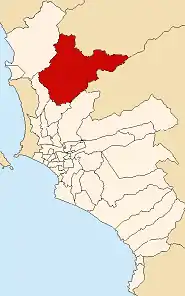Carabayllo District
Carabayllo is one of the 43 districts of the province Lima in Peru. It is located in the Cono Norte area of the province and was founded by General José de San Martín in August 1821 at which time it was the only district to occupy the area north of the Rímac River up to the province Canta.[1]
Carabayllo | |
|---|---|
 Flag  Coat of arms | |
 Location of Carabayllo in the Lima province | |
| Coordinates: 11°51′S 77°02′W | |
| Country | |
| Region | Lima |
| Province | Lima |
| Founded | August 4, 1821 |
| Capital | Carabayllo |
| Subdivisions | 50 populated centers |
| Government | |
| • Mayor | Marcos Espinoza Ortiz (2019-2022) |
| Area | |
| • Total | 346.88 km2 (133.93 sq mi) |
| Elevation | 238 m (781 ft) |
| Population (2017) | |
| • Total | 333,039 |
| • Density | 960/km2 (2,500/sq mi) |
| Time zone | UTC-5 (PET) |
| UBIGEO | 150106 |
| Website | municarabayllo.gob.pe |
Boundaries
It borders to the north and east with the Canta Province in the Lima Region, the south with the Comas district and the San Juan de Lurigancho district, and to the west with the Puente Piedra and Ancón districts.
History
Carabayllo was the first district to be created by decree in the Lima Province by General José de San Martín in the independence era on August 4, 1821.[2] At that time the district occupied the whole Chillón valley north of the Rímac River up to the Canta province. Through the years the district lost most of its territory to newly created districts following the growth of economic activity and the growth of the population in the area. This process started as early as 1874 when the Ancón District was created and continued to as recent as 1961 when the Comas District was created and as recent as 1969 when the Ventanilla District was founded in neighboring Callao Province.[1] Carabayllo still remains the largest district in Lima with an area of 346 km2 and a population of about 200,000 (2005).[3] Carabayllo is a zone of recent expansion to the city. The principal road connecting the district to the rest of the metropolis is the Tupac Amaru Avenue. It is at an altitude of 238 meters above sea level. Its social economic level is principally made up of middle and lower middle classes.
References
- (in Spanish) Carabayllo Portal, La Historia de Carabayllo por Edgar Quispe Pastrana Archived 2009-01-22 at the Wayback Machine, retrieved November 1, 2008.
- Alberto Tauro del Pino, Enciclopedia Ilustrada del Perú, vol. XV, p. 2414.
- (in Spanish) Instituto Nacional de Estadística e Informática. Banco de Información Distrital Archived April 23, 2008, at the Wayback Machine. Retrieved November 1, 2008.
External links
- (in Spanish) Official web site
- (in Spanish) Portal of Carabayllo District